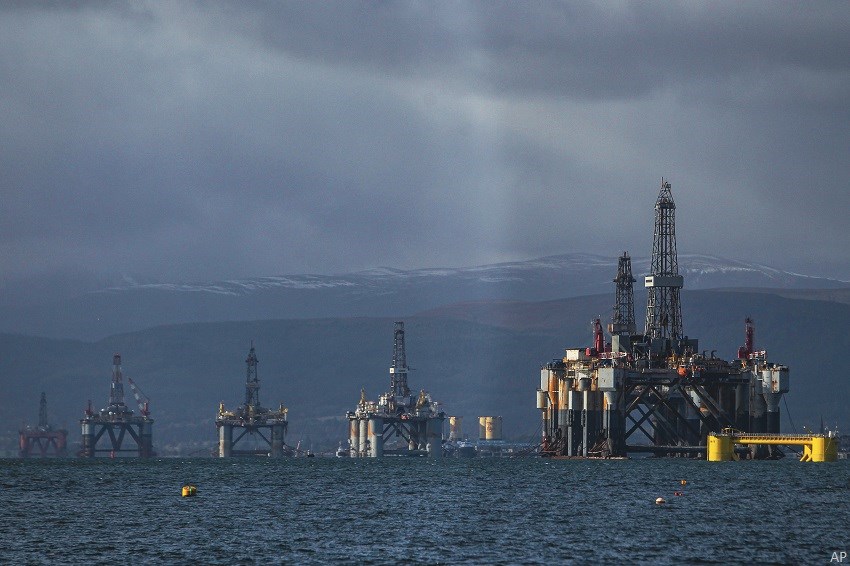
Dividend investors have a new sector to explore when digging for companies with high and growing income: energy companies.
Dividend-paying energy companies aren’t anything new, of course. What is new is that in recent years, the sector has seen a rush of companies initiating dividends for the first time--and existing dividend payers sharply boosting their payouts.
Dividend Investors' Income Has Skyrocketed Since 2016
Energy companies are facing the prospects of a long-term decline in demand for oil and gas, concerns about climate change, and the push to renewable energy. In response, they’re taking their profits and rather than using that money to drill new wells are sending cash back to investors. As a result, the energy sector’s dividends are growing faster than any other part of the U.S. equity market. Since 2018, the average dollar amount of dividends among energy companies has grown by over 50%. That’s up from just 5% growth for the prior three years. And since 2016, energy companies’ dividend amounts are up 80% for the five-year period.
Diamondback Energy (FANG) has raised its dividend roughly 370% in the past three years, EOG Resources (EOG) more than 500% and Pioneer Natural Resources (PXD) by more than 2,000%. Pioneer’s dividend boost is also an example of energy companies adopting a new strategy of offering so-called variable dividends, which allows them to pay out more cash to shareholders when oil prices rise as they did in 2021, but lower that payout when times get tough.
“It used to be that the way to run a good exploration and production business was to invest as much capital as possible into highly profitable shale wells--to drill as much as possible while demand for crude oil was really high,” says Dave Meats, Morningstar’s director of equity research for energy and utilities.
But facing the prospects of lower demand for oil as consumers switch to electric vehicles and renewable energy becomes a greater segment of the economy, it no longer makes economic sense to just pump money into drilling wells. “They’ve got to do something with the cash--if they don’t have anything attractive to invest in, then return on capital (to investors) makes more sense,” says Meats.
Bill Nygren, manager of Oakmark Fund (OAKMX) and CIO for U.S. equities at Harris Associates, says this focus on return on capital has changed the dynamics for investing in energy companies. “With the exception of the past year, this has been a lousy area to invest in for the past decade. It looked like a double-black-diamond ski slope on the way down and a bunny slope on the way up” when it came to stock prices, he says. Now, “we’re very pleased with what we see in the industry. Companies are producing more cash and returning a higher percentage of it to the shareholders.”

Driving that double-black-diamond collapse in energy stocks was a significant decline in oil prices. Before 2015, oil prices spent years in the $90 to $100 per barrel range. But until early 2021, prices bounced mostly between $35 and $65 thanks to a combination of surging production and slowing demand. During that time period, the Morningstar US Energy Index lost 8.79%--far behind all other sector indexes for the same period, and the only sector to end the five-year period at a loss.
While the downward pressure on oil prices was largely driven by short-term considerations, environmental concerns are playing a bigger role in the long-term outlook. Even industry giants such as Exxon are being forced to contemplate a world with declining demand for oil.
Meanwhile, with the rise of sustainable investing, a growing percentage of investor dollars are no longer flowing to energy companies. The energy sector has by far the worst environmental, social, and governance ratings profile in the market. Out of the 11 stock market sectors, it’s the only one currently rated by Sustainalytics as having “high” ESG risk.
“In a business with an existential demand crisis, you can’t continue throwing money at growth projects. Demand simply won’t keep up,” says Tyler Dann, head of research at Morningstar Investment Management. “Do we need to be growing this much, spending this much when the demand for fossil fuels might be gone in 30 years?”
Instead, these energy companies are compensating investors by increasing the size of their dividends--while investing selectively in short-term growth projects with a high return on investment. “Today, and over the next few years, there’s still a need to supply markets with oil and gas product,” Dann says.
In the meantime, oil and gas companies are now flush with cash, thanks to last year’s jump in oil prices. “A few years ago, oil was priced at US$40-US$50 per barrel,” notes Nygren. At January’s end, the price of oil reached US$92 per barrel. “Now that companies are earning more cash flow, they have more to distribute to shareholders.’’

As a result, the number of oil and gas companies that pay dividends has grown. In 2016, 58% of the oil and gas companies in the Morningstar US Market Index were paying dividends to their shareholders. By the end of 2021, the figure rose to 76%. That’s an increase of 18% and more than any other sector in the market.

In dollar terms, most of the energy sector’s dividend growth comes from the oil and gas exploration and production industry. Since 2018, the average dividend in dollars per share among exploration and production companies has grown to US$40 from US$14, an increase of more than 180%.

Energy Companies Explore the Potential of Variable Dividends
One relatively new feature for energy stocks is variable dividends. When it comes to dividends, the traditional method for the payouts is that companies offer a fixed amount they expect to deliver to shareholders. While investors applaud companies having the financial strength to raise a dividend, the market often severely punishes their shares when dividends are reduced. The drawback is that doesn’t offer much flexibility.
Oil and gas companies are facing a host of concerns: long-term demand for fossil fuels, risk of oversupplying, pleasing a shareholder base that wants both dividends and plans for responsible decarbonization. “There are a lot of moving parts,” says Dann. “Variable dividends have emerged as one solution.”
Variable dividends allow companies to temporarily increase the size of their payments while cash flows are high without going into debt or cutting their dividends when cash flows are lower.
“Dividends stay manageable in downturns, and investors benefit directly when oil prices are high,” Meats explains. “The companies doing this now are trailblazers. Eventually, we expect the entire industry to head toward variable dividends.”
Pioneer Natural Resources, Devon Energy (DVN), and Coterra Energy (CTRA) are examples of energy companies with variable dividends. All three first introduced their first variable dividends in 2021. Diamondback Energy and EOG Resources are taking the alternate route of share buybacks--a less-visible form of passing cash flow to investors.

Nygren points to ConocoPhillips (COP) as an example of how variable dividends can lead to wins for dividend investors. Conoco is a 2% position in the US$18.9 billion Oakmark Investor fund, where Nygren is a comanager.
“What really intrigued us about Conoco was that they have a different attitude about returning capital than most of the other large, international energy companies,” Nygren says. “They’ve admitted that there’s no reason investors should consider them an advantaged player in the renewable space--so instead, they’re returning the capital to shareholders and letting us decide where to invest.”
Nygren highlights plans by ConocoPhillips to return US$75 billion to their investors in the form of dividends over the next 10 years as long as the price of oil averages US$50 per barrel (much lower than the current price of over $90 per barrel). “Conoco’s total market cap is only US$110 billion,” he adds. “So, you’re getting back almost two thirds of your investment through share repurchases and dividends.” If the price of oil averages US$65 per barrel over the next 10 years, ConocoPhillips could be returning 100% of capital to investors, according to Nygren. Today, the 10-year average price of oil per barrel stands at about US$85.
5 Energy Companies Worth a Closer Look for Dividend Investors
Here are Morningstar Analyst takes on a selection of U.S.-based oil and gas companies within the exploration and production industry that have been growing their dividends. These energy companies have earned Morningstar Economic Moat Ratings of narrow, meaning they have competitive advantages strong enough to fend off competition and earn strong returns on capital for up to 10 years into the future:
Pioneer Natural Resources
“We believe Pioneer has the ability to earn sustainable excess returns on invested capital, justifying a narrow moat rating. The company operates exclusively in the Permian Basin, which is the cheapest source of crude oil in the U.S.--sitting below other shale plays, deep-water projects, and all other unconventional sources on the global cost curve. Pioneer is ideally located within the play as well. That’s important because the precise surface location of a horizontal shale well plays a huge part in determining its eventual productivity and also influences the oil content of its production stream. By focusing on areas that typically yield very impressive initial flow rates, Pioneer’s fixed costs, such as drilling and completions, are spread more thinly, delivering more bang for the buck. The firm's ideally located acreage also supports above-average unit revenue, as oil cuts are generally strong.”
--Dave Meats, director
EOG Resources
“Until recently, very few shale producers were paying attention to shareholder returns, but EOG was one of them. The firm actually delivered excess returns on invested capital for five of the six years of 2009-14, before the downturn in global crude prices began. That pushed returns back in negative territory for several years. But a relentless focus on cost-cutting, productivity, and efficiency eventually paid off, enabling EOG to start earning its cost of capital again and qualifying the firm for a narrow moat rating.”
--Dave Meats, director
Diamondback Energy
“Keeping costs low is baked into the culture at Diamondback, and we expect operations to remain lean and efficient, despite the recent expansions. From the outset, the company has enjoyed a competitive advantage that enables it to systematically undercut its upstream peers. This was initially based on the ideal location of its acreage in the core of the basin, and helped by the early adoption of innovations like high-intensity completions (resulting in more production for each dollar spent). More recently, the firm has started seeing significant economies of scale as well.”
--Dave Meats, director
Coterra
“Coterra is one of the few exploration and production companies to earn a narrow moat rating. The ability to deliver sustainable excess returns on invested capital is a hallmark of moaty companies, and the firm is expected to earn its cost of capital for at least the next 10 years. The recent merger with Cimarex slightly diluted our ROIC projections, but we still expect a 5% margin of safety over weighted average cost of capital through our 10-year forecast.”
--Dave Meats, director
ConocoPhillips
“Differentiating itself from peers big and small, ConocoPhillips has laid out a 10-year plan for restrained investment, steady growth, improving returns, and, importantly, returning cash to shareholders. Its strategy makes Conoco a compelling option in the energy sector, given its commitment to capital restraint and clear policy on return of cash to shareholders. Its low-cost portfolio gives it high return investment options to grow in a rising price environment while its strong financial position keeps the dividend safe in a downcycle.”
--Allen Good, sector strategist




















